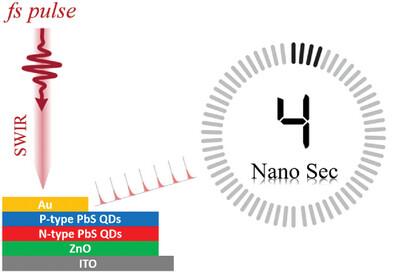当前位置:
X-MOL 学术
›
Adv. Mater.
›
论文详情
Our official English website, www.x-mol.net, welcomes your feedback! (Note: you will need to create a separate account there.)
Short-Wave Infrared Colloidal QD Photodetector with Nanosecond Response Times Enabled by Ultrathin Absorber Layers
Advanced Materials ( IF 29.4 ) Pub Date : 2024-04-24 , DOI: 10.1002/adma.202402002 Yu‐Hao Deng 1, 2 , Chao Pang 2, 3 , Ezat Kheradmand 1, 2 , Jari Leemans 1, 2 , Jing Bai 1, 2 , Matthias Minjauw 4 , Jiayi Liu 2, 5 , Korneel Molkens 1, 2 , Jeroen Beeckman 2, 5 , Christophe Detavernier 4 , Pieter Geiregat 1, 2 , Dries Van Thourhout 2, 3 , Zeger Hens 1, 2
Advanced Materials ( IF 29.4 ) Pub Date : 2024-04-24 , DOI: 10.1002/adma.202402002 Yu‐Hao Deng 1, 2 , Chao Pang 2, 3 , Ezat Kheradmand 1, 2 , Jari Leemans 1, 2 , Jing Bai 1, 2 , Matthias Minjauw 4 , Jiayi Liu 2, 5 , Korneel Molkens 1, 2 , Jeroen Beeckman 2, 5 , Christophe Detavernier 4 , Pieter Geiregat 1, 2 , Dries Van Thourhout 2, 3 , Zeger Hens 1, 2
Affiliation

|
Ultrafast short-wavelength infrared (SWIR) photodetection is of great interest for emerging automated vision and spatial mapping technologies. Colloidal quantum dots (QDs) stand out for SWIR photodetection compared to epitaxial (In,Ga)As or (Hg,Cd)Te semiconductors by their combining a size-tunable bandgap and a suitability for cost-effective, solution-based processing. However, achieving ultrafast, nanosecond-level response time has remained an outstanding challenge for QD-based SWIR photodiodes (QDPDs). Here, record 4 ns response time in PbS-based QDPDs that operate at SWIR wavelengths is reported, a result reaching the requirement of SWIR light detection and ranging based on colloidal QDs. These ultrafast QDPDs combine a thin active layer to reduce the carrier transport time and a small area to inhibit slow capacitive discharging. By implementing a concentration gradient ligand exchange method, high-quality p–n junctions are fabricated in these ultrathin QDPDs. Moreover, these ultrathin QDPDs attain an external quantum efficiency of 42% at 1330 nm, due to a 2.5-fold enhanced light absorption through the formation of a Fabry–Perot cavity within the QDPD and the highly efficient extraction (98%) of photogenerated charge carriers. Based on these results, it is estimated that a further increase of the charge-carrier mobility can lead to PbS QDPDs with sub-nanosecond response time.
中文翻译:

由超薄吸收层实现纳秒响应时间的短波红外胶体量子点光电探测器
超快短波红外 (SWIR) 光电探测对于新兴的自动视觉和空间测绘技术非常感兴趣。与外延 (In,Ga)As 或 (Hg,Cd)Te 半导体相比,胶体量子点 (QD) 在短波红外光电检测方面脱颖而出,因为它们结合了尺寸可调的带隙和经济高效、基于解决方案的处理的适用性。然而,对于基于 QD 的短波红外光电二极管 (QDPD) 来说,实现超快纳秒级响应时间仍然是一个突出的挑战。在此,报道了在短波红外波长下工作的基于PbS的QDPD的创纪录的4纳秒响应时间,结果达到了基于胶体量子点的短波红外光检测和测距的要求。这些超快 QDPD 结合了薄有源层以减少载流子传输时间和小面积以抑制缓慢的电容放电。通过实施浓度梯度配体交换方法,在这些超薄 QDPD 中制造出高质量的 p-n 结。此外,这些超薄 QDPD 在 1330 nm 处实现了 42% 的外量子效率,这是由于通过在 QDPD 内形成法布里-珀罗腔而使光吸收增强了 2.5 倍,并且光生电荷的高效提取 (98%)载体。基于这些结果,估计电荷载流子迁移率的进一步增加可以导致具有亚纳秒响应时间的PbS QDPD。
更新日期:2024-04-24
中文翻译:

由超薄吸收层实现纳秒响应时间的短波红外胶体量子点光电探测器
超快短波红外 (SWIR) 光电探测对于新兴的自动视觉和空间测绘技术非常感兴趣。与外延 (In,Ga)As 或 (Hg,Cd)Te 半导体相比,胶体量子点 (QD) 在短波红外光电检测方面脱颖而出,因为它们结合了尺寸可调的带隙和经济高效、基于解决方案的处理的适用性。然而,对于基于 QD 的短波红外光电二极管 (QDPD) 来说,实现超快纳秒级响应时间仍然是一个突出的挑战。在此,报道了在短波红外波长下工作的基于PbS的QDPD的创纪录的4纳秒响应时间,结果达到了基于胶体量子点的短波红外光检测和测距的要求。这些超快 QDPD 结合了薄有源层以减少载流子传输时间和小面积以抑制缓慢的电容放电。通过实施浓度梯度配体交换方法,在这些超薄 QDPD 中制造出高质量的 p-n 结。此外,这些超薄 QDPD 在 1330 nm 处实现了 42% 的外量子效率,这是由于通过在 QDPD 内形成法布里-珀罗腔而使光吸收增强了 2.5 倍,并且光生电荷的高效提取 (98%)载体。基于这些结果,估计电荷载流子迁移率的进一步增加可以导致具有亚纳秒响应时间的PbS QDPD。



























 京公网安备 11010802027423号
京公网安备 11010802027423号